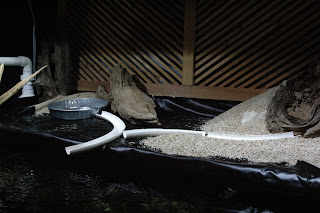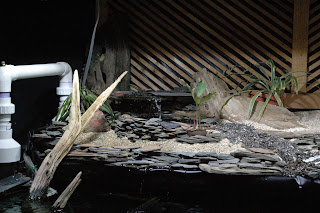A common affliction of the aquariast is multiple-tank syndrome (MTS). Once you master one tank, you begin to find other fish and/or plants you would like to keep that are incompatible with the ones you have. Or maybe you decide that a spot in the house or your desk at work could use a tank. Here are some, but not all of our current tanks...
This 150g is actually the first serious plant tank we built. It has been moved from Fort Worth to Dallas and rearranged several times since then. It is slated for replacement someday when we've paid off all the other aquarium stuff we've acquired lately. It is home to our oldest clown loaches, a favorite of ours both for its utility as a snail eater as well as its personality.

A closeup of one of our clown loaches:

This is a 60g 24x24x24" cube, perhaps my favorite form factor for a tank. It replaced a 30g hex tank which the Angel fish outgrew. The grid in the back will eventually be covered with Christmas moss, a dense moss that hangs off surfaces in triangular Christmas tree-like patterns. I got some online and spread it out behind the grid so it will grow through in time.

This 20g was our original hospital/quarantine tank, but became a Goodeid breeding tank for a while, and here primarily houses a pair of Gold Rams (middle, right) that we are hoping will spawn.

This is a 12g Nano cube tank that I bought and had on my desk at my previous job. It had fake plants in it at the time. I thought it would make it easier to care for, but it wasn't worth it. I eventually brought it home and put real plants in it. On the glass on the right is a CO2 reactor. The tank has two (not sure if it's a pair or not) gold rams with stripes, sold as gold rams, but distinctly different from the gold rams in the other tank. Perhaps they were cross bread with the blue rams as the stripes match those. Apparently the fully gold ones were actually bred from the blue rams, so maybe these were an interim stage. This tank is in my bedroom and gets neglected compared to the tanks out where I spend most of my time.

This 72g bowfront was originally purchased with the intention of becoming what the 215/240g tank became. The stand is decorated with slate, as is the back glass of the tank. It was going to have the bog area, etc. But it was determined that it wasn't really big enough for what we wanted to do. So it sat empty for more than a year. Here we finally set it up with the intention of making it a lightly planted South American Cichlid tank.


























